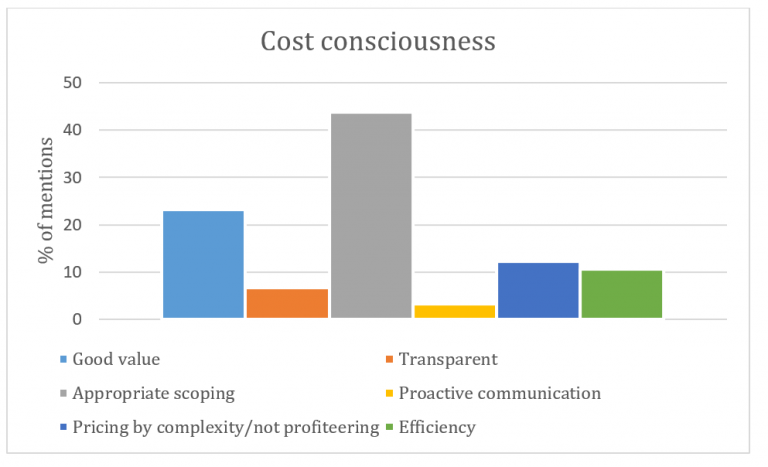The following explanations of the beatonbenchmarks attributes are designed to highlight what matters most to respondents when they rate your firm. While the content of these explanations is largely intuitive, the relative weight given by respondents to the attributes’ constituent elements is useful in determining where to invest your firm’s effort. To download the full explanation document, click on the button below.
Preamble
The method for this attribute analysis was simple. We asked beatonbenchmarks survey respondents to define our attributes, categorising and summarising their responses below.
Note that the y-axis refers to ‘% of mentions’, i.e. the mentions of a particular element as a percentage of all mentions. These mentions are not mutually exclusive, as some respondents mention multiple elements. It should be noted that elements of an attribute with only few mentions were omitted from this analysis to maintain focus on more important elements.
A high proportion of mentions is an imperfect proxy for importance – an element with few mentions may be highly collinear with an element with many mentions. However, a high proportion of mentions reflects the fact that when thinking about these attributes, specific elements of the attributes are top of mind for most clients.
These explanations should therefore be seen as a high level summary of what the attributes in the beatonbenchmarks mean to the majority of respondents. It should complement, not supplement, knowing your clients and tailoring your service to their individual expectations.
Example - Cost consciousness
Appropriate scoping (43%) is the most mentioned element of Cost consciousness. That is, accurately scoping the work to be done at a size and cost suitable for the client. The second most mentioned element of Cost consciousness is Good value (23%). Relatively minor elements according to respondents include not overcharging for simple work (Pricing by complexity/not profiteering at 12%), Efficiency (10%), Transparent costing (7%) and Proactive communication with respect to costs (4%). Only a very small proportion of respondents mentioned cheap pricing as representing Cost consciousness.
Accordingly, the best return on effort is likely to be achieved in this attribute through scoping work appropriately.



Concluding comments
Close study of these explanations of the attributes used in the beatonbenchmarks reveals considerable overlap. This is not unexpected as individuals use different interpretations of the same phrase when answering a question. To the extent possible, beaton has separated the meanings of each attribute in a way that is practically actionable by firms.
These explanations are not profession specific. This is because beaton has found that there are no significant differences in responses across different professions. This lends weight to our hypothesis that despite nuances, there are fundamental commonalities in client service and project delivery that apply across the professions.
NOTICE: All the material in this post is the property of Beaton Research + Consulting Pty Ltd. It is intended for the purposes of assisting subscribers to the beatonbenchmarks interpret and take action on their report. Subscribers to beatonbenchmarks reports are bound by the Terms & Conditions of their subscription, a copy of which may be obtained from ewa.foroncewicz@beatonglobal.com
The beaton attribute model of professional services has been refined and tested from over 35+ years’ research.
The corresponding post type is disabled. Please make sure to 1) install The7 Elements plugin under The7 > Plugins and 2) enable desired post types under The7 > My The7, in the Settings section.




